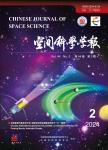A Method of Inversing the Peak Density of Atomic Oxygen Vertical Distribution in the MLT Region From the OI (557.7 nm)Night Airglow Intensity
A Method of Inversing the Peak Density of Atomic Oxygen Vertical Distribution in the MLT Region From the OI (557.7 nm) Night Airglow Intensity作者机构:Laboratory for Space Weather Center for Space Science and Applied Research Chinese Academy of Sciences Beijing 100080 China China-Russia Joint Research Center on Space Weather Graduate School Chinese Academy of Sciences Beijing 100039
出 版 物:《空间科学学报》 (Chinese Journal of Space Science)
年 卷 期:2005年第25卷第5期
页 面:484-489页
核心收录:
学科分类:07[理学] 070401[理学-天体物理] 0704[理学-天文学]
基 金:Supported by the National Science Foundation of China (40225011 40336054)National Research Project (G2000078407)project of CAS (KZCX3-SW-217)International Collaboration Research Team Program of the Chinese Academy of Sciencesthe China-Russia Joint Research Center on Space WeatherChinese Academy of Sciences
摘 要:In this paper, using the MSISE-90 model as the reference atmosphere, we discuss the feasibility and method of deducing the peak densities of the undisturbed atomic oxygen profiles in the MLT region (the mesosphere and lower thermosphere region) from OI (557.7 nm) night airglow intersities. The peak densities for different seasons, latitudes and longitudes are deduced from OI (557.7nm) airglow intensities through this expression. We analyze the features of inversion relative errors and discuss the influence of the variations in temperature on inversion errors. The results indicate that all inversion errors are less than 5% except for those at high altitudes in the summer hemisphere. And the impact of the variations in temperature on errors is not significant.



